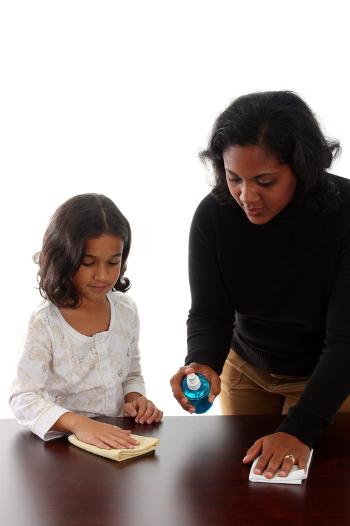Cleaning up after a meal
Duration/age

Your family has finished their meal together and now it’s time to clean up. Who is going to clear it all away? You could ask your child to help.
Talk with your child about where to start. Do you need to pack away the plates and other things from the table first? Is it possible to just wipe the table straightaway?
We need to put away the containers and dishes before we can wipe the table clean.
You can put the serviettes into the rubbish bin while I carry the heavy plates to the kitchen sink.
As you clean up with your child, talk about what needs to be done next.
When I have finished carrying the plates to the kitchen you can help me wipe the table. We will start at the outside of the table and work towards the middle.
Materials you will need
- Dish cloth or sponge
Alternative tools
- Paper towel
- A broom
- A dustpan
Skills this activity improves
Why does this matter?
When your child helps you to clean up they are exploring area and perimeter and developing language to describe position, location and movement.
As they help you to clean the table, sweep up or put away the dishes they will be hearing and following directions that involve position, location and number. When they hear the direction they will be developing planning skills as they work out where to start, where to place the dishes and how to move around the physical space.
When children are involved in the set-up and following of family routines they are learning to follow direction, listen to instructions and to predict what will happen next. As they do this they learn that a routine is regular, planned and that it will happen in the same order each time.
What does this lead to?
Encouraging your child to help with cleaning up helps them to understand that they can use and move their bodies in many ways. Exploring how we can move our body in space helps children to navigate themselves through the environment and to develop spatial awareness.
As they explore the different ways their bodies move they are learning about measurement, space and size and how to move within and around objects.
As your child moves they’re using all of their body and senses. They are developing strength, control and coordination in all of their body parts including the large muscles in their trunk. Having a strong core, or trunk, is important as it helps children to develop a good sitting posture.
Language to use
- Table, sink, floor
- Kitchen, dining room, family room
- First, start, next, now, last, finish
- Middle, edge, side, perimeter, outside
- Top, bottom, underneath, against
- Wipe, sweep, clean, carry
Questions to use
- What do we need to do before we can wipe the table?
- Where will we put the dishes?
- What can you use to clean up the crumbs on the floor?
- Can you wipe the table if it has a tablecloth on it?
Useful tips
- Setting up routines for daily chores is as important as family celebrations or family time together. Your child will begin to understand that routines can be fun and enjoyable and not only about work or completing tasks.
- You might also like to take a look at the activities Sweeping and Routines.
- Help your child to squeeze the water out of their sponge so it doesn't drip all over the floor.
- Remember to talk to your child in your home language.
More ideas
Create a reward chart for the family chores. Try and collect 10 stickers as a family. Once you have 10 stickers the whole family can have a reward.
Variation by age
Three to five year olds
- Create a job chart that shows all the different jobs your child can help with.
- Sing songs as you work together.


